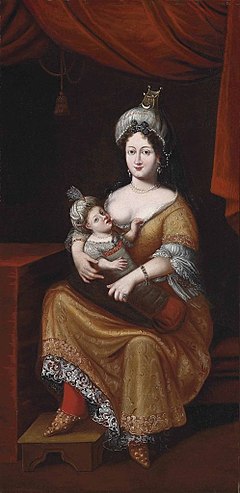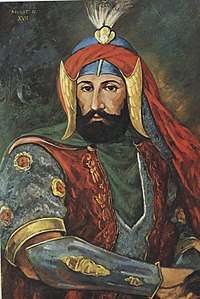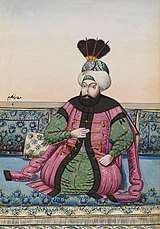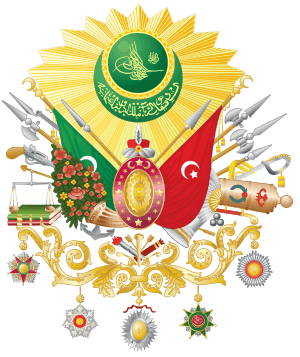Kösem Sultan
Kösem Sultan (Ottoman Turkish: كوسم سلطان, IPA: [cœˈsæm suɫˈtan]) (c. 1589[1] – 2 September 1651[7]) – also known as Mahpeyker Sultan[8][5] (Turkish pronunciation: [mahpejˈkæɾ suɫˈtan]; from the Persian compound ماه پيكر Māh-peyker meaning "moon framed") – was one of the most powerful women in Ottoman history.[9] Kösem Sultan achieved power and influenced the politics of the Ottoman Empire when she became haseki sultan as favourite consort of Ottoman Sultan Ahmed I (r. 1603–1617) and valide sultan[8] as mother of Murad IV (r. 1623–1640) and Ibrahim (r. 1640–1648), and grandmother of Mehmed IV (r. 1648–1687).
| Kösem Sultan | |
|---|---|
 | |
| Naib-i-Sultanat of the Ottoman Empire (first regency) | |
| Regency | 10 September 1623 – 18 May 1632 |
| Predecessor | None |
| Successor | Turhan Sultan |
| Regent | Murad IV |
| (second regency) | |
| Regency | 8 August 1648 – 2 September 1651 |
| Successor | Turhan Sultan |
| Monarch | Mehmed IV |
| Valide Sultan of the Ottoman Empire | |
| Tenure | 10 September 1623 – 2 September 1651 |
| Predecessor | Halime Sultan |
| Successor | Turhan Sultan |
| Haseki Sultan of the Ottoman Empire (Imperial Consort) | |
| Tenure | 26 November 1605 – 22 November 1617 |
| Predecessor | Safiye Sultan |
| Successor | Ayşe Sultan |
| Born | c. 1589[1] Tinos, Republic of Venice (currently the territory of Greece) |
| Died | 2 September 1651 (aged 61–62) Constantinople, Ottoman Empire (present-day Istanbul, Turkey) |
| Burial | |
| Spouse | Sultan Ahmed I |
| Issue |
|
| Religion | Sunni Islam (raised Greek Orthodox) |
Kösem lived in the Ottoman Empire as a courtier during the reign of six sultans: Ahmed I, Mustafa I, Osman II, Murad IV, Ibrahim, and Mehmed IV. After her death, she was known by the names "Valide-i Muazzama" (magnificent mother), "Vālide-i Maḳtūle" (murdered mother), and "Vālide-i Şehīde" (martyred mother).[10]
Early life
Kösem is generally said to be of Greek origin,[11] the daughter of a priest on the island of Tinos whose maiden name was Anastasia,[12][13][14] but these views do not seem reliable.[1] She was bought as a slave by the Bosnian Beylerbey, and sent, at the age of fifteen, to the harem of Sultan Ahmed I. Upon her conversion to Islam, her name was changed to Mahpeyker ("Moon-Faced" in Persian, meaning "beautiful"),[15] and later by Sultan Ahmed I to Kösem,[16] meaning "leader of the herd", indicating Kösem's leadership and political intelligence.
Haseki Sultan, the Imperial Consort
Kösem rose to prominence early in Ahmed's reign as part of a series of changes to the hierarchy of the imperial harem. Safiye Sultan, Ahmed's once-powerful grandmother and manager of the harem, was deprived of power and banished to the Old Palace (Eski Saray) in January 1604, and Handan Sultan, Ahmed's mother and Valide Sultan, died in November of the following year. These two vacancies allowed Kösem to rise to the top of the imperial harem hierarchy from her previous position as the Sultan's second or third concubine.[5]
As a Haseki Sultan to Ahmed I Kösem was considered his favorite consort and gave birth to many of his children.[5] During her time as haseki sultan she received 1,000 aspers a day.[17] As the mother to a number of princesses she had the right to arrange their marriages which were of political use.[5] Venetian ambassador Simon Contarini mentions Kösem in his report in 1612 and portrays her as:
"[A woman] of beauty and shrewdness, and furthermore ... of many talents, she sings excellently, whence she continues to be extremely well loved by the king ... Not that she is respected by all, but she is listened to in some matters and is the favorite of the king, who wants her beside him continually."[5]
Contarini reported in 1612 that the Sultan ordered a woman to be beaten for having irritated Kösem. She may have been Kösem's fellow consort Mahfiruz, mother of Ahmed's eldest son Osman.[18] Kösem also made efforts to keep her brother-in-law Mustafa safe from execution, and may have regarded Mahfiruz as a rival intent on lobbying in favor of her own son.[18] After Mahfiruz's apparent expulsion from the palace, probably in the mid-1610s, Kösem and Osman grew fond of each other. She used to let him join her in carriage rides where he showed himself to the crowd, but once this came to Ahmed's attention he forbade any conversation between them.[19]
Kösem's influence over the Sultan increased in the following years and it is said that she acted as one of his advisers.[5] However, she refrained from involving herself constantly in serious issues as the Sultan refused to be overshadowed by his wife.[5] Kösem is sometimes accused of trying to save her own position and influence throughout her long career "rather than that of the sultan or of the dynasty".[20]
Kösem also had a long career as a guardian of şehzades. It is possible that the significant modifications in the pattern of succession to the throne during Ahmed's time owed something to her efforts. She must have realized the personal gain that might stem from the transition to seniority coupled with the fact that she was no longer haseki but had a son "in waiting". According to the Venetian ambassador, Kösem "lobbied to spare Mustafa the fate of fratricide with the ulterior goal of saving her own son from the same fate."[21]
Retirement at the Old Palace
Like his parents, Ahmed died at a young age (27 years) on 22 November 1617. This made Kösem lose her position in Topkapi Palace and she retired in the Old Palace during the reign of her brother-in-law Mustafa I and step-son Osman II.
Due to the emergence of seniority as the principle of succession, which meant that a prince's mother might mark time in the Old Palace between the death of her master and the accession of her son, Kösem was able to maintain her Haseki status and daily stipend of 1,000 aspers during her retirement there;[22] still, after the end of Kösem's tenure as haseki, the position lost its prominence.[20]
In 1619, her step-son Osman II paid her a three-day visit at the Old Palace, thus manifesting his special fondness for her. Even if their relation was cultivated, though, it did not yield consequential results for the young Sultan, whose most exceptional weakness was the lack of a Valide Sultan, a queen mother, to lobby in his favour.[19]
Valide Sultan, the Sultan's Mother and regent
First tenure
Kösem came back in power when her son ascended to the throne on 10 September 1623 as Murad IV. Since her son was a minor, she was appointed not only as a Valide Sultan but also, as an official regent (naib-i-sultanat) during his minority, from her son's ascension on 10 September 1623 until 18 May 1632. During most of Murad IV's reign, she essentially ruled through him and effectively ran the empire, attending meetings of the divan (cabinet) from behind a curtain, even after 1632, when she was no longer regent.
During the early years, the Empire fell into anarchy; the Safavid Empire invaded Iraq almost immediately, Northern Anatolia erupted in revolts, and in 1631 the Janissaries stormed the palace and killed the Grand Vizier, among others. Murad feared suffering the same fate as his elder brother, Osman II, and decided to assert his power. He later tried to quell the corruption that had grown during the reigns of previous Sultans, and that had not been checked while his mother was ruling through proxy. His absolute rule started around 1632, when he took the authority and repressed all the tyrants, and he re-established the supremacy of Sultan.
Second tenure
Kösem's other son, Ibrahim, lived in terror of being the next of his brothers to be executed by Murad's order. His life was only saved by the intercession of his mother Kösem Sultan.[1] After Murad's death, Ibrahim was left the sole surviving prince of the dynasty. Upon being asked by the Grand Vizier Kemankeş Kara Mustafa Pasha to assume the Sultanate, Ibrahim suspected Murad was still alive and plotting to trap him. It took the combined persuasion of Kösem and the Grand Vizier, and personal examination of his brother's dead body, to make Ibrahim accept the throne. When Ibrahim succeeded his brother in 1640, he proved too mentally unstable to rule. This enabled Kösem to continue in power. He was encouraged by his mother to distract himself with harem girls. The distractions of the harem allowed Kösem to gain power and rule in his name, yet even she fell victim to the Sultan's disfavor and left the Imperial Palace.[1]
Ibrahim's behaviour sparked talks of deposing the sultan. In 1647, the Grand Vizier Salih Pasha, Kösem Sultan, and the şeyhülislam Abdürrahim Efendi unsuccessfully plotted to depose the sultan and replace him with one of his sons. Salih Pasha was executed and Kösem Sultan was exiled from the harem.[23] The next year the Janissaries and members of the ulema revolted. On 8 August 1648, Ibrahim was dethroned, seized and imprisoned in Topkapı Palace.[1][24] Kösem gave consent to her son's fall, saying "In the end he will leave neither you nor me alive. We will lose control of the government. The whole society is in ruins. Have him removed from the throne immediately."[25] The new Grand Vizier, Sofu Mehmed Pasha, petitioned the Sheikh ul-Islam for a fatwā sanctioning Ibrahim's execution. It was granted, with the message "if there are two Caliphs, kill one of them." Kösem also gave her consent. Two executioners were sent.[26] Ibrahim was strangled on 18 August 1648.[27]
Third tenure
Eventually Kösem presented her seven-year-old grandson Mehmed IV to the divan with the words "Here he is!, see what you can do with him!" Thus, she declared herself regent for the third time, and ruled openly again between 1648 and 1651. At the head of the Ottoman Empire stood the child sultan, Mehmed IV. With Mehmed's ascendancy, the position of Valide Sultan ("mother of the reigning sultan") should have gone to his mother Turhan Sultan. However, Turhan was overlooked due to her youth and inexperience. Instead Kösem Sultan was reinstated to this high position. Kösem Sultan was a valide (mother) under two sons, thus having the more experience of the two women.[28]
Death

It was Mehmed IV's mother, Turhan, who proved to be Kösem's nemesis. When she was about 12 years old, Turhan was sent to the Topkapı Palace as a gift, from the Khan of Crimea, to Kösem Sultan.[29][30] It was probably Kösem Sultan who gave Turhan to Ibrahim as a concubine. Turhan turned out to be too ambitious a woman to lose such a high position without a fight. In her struggle to become Valide Sultan, Turhan was supported by the chief black eunuch in her household and the grand vizier, while Kösem was supported by the Janissary Corps. Although Kösem's position as Valide was seen as the best for the government, the people resented the influence of the Janissaries on the government.[31]
In this power struggle, Kösem planned to dethrone Mehmed and replace him with another young grandson. According to one historian, this switching had more to do with replacing an ambitious daughter-in-law with one who was more easily controlled. The plan was unsuccessful as it was reported to Turhan by Meleki Hatun, one of Kösem's slaves, that Kösem was said to be plotting Mehmed's removal and replacement by another grandson with a more pliant mother.[31] Whether Turhan sanctioned it or not, Kösem Sultan was murdered three years after becoming regent for her young grandson. It is rumoured that Turhan ordered Kösem's assassination. Furthermore, some have speculated that Kösem was strangled with a curtain by the chief black eunuch of the harem, Tall Suleiman. The Ottoman renegade Bobovi, relying on an informant in the harem, states that Kösem was strangled with her own hair.[32]
After her death her body was taken from Topkapi to the Old Palace (Eski Sarayı) and then buried in the mausoleum of her husband Ahmed I.[33]
Charities
Kösem made charities and donations both for people and ruling class in the state. She visited the prisons every year, paid the debts of imprisoned people, supplied the trousseaus of daughters of poor families and servant girls trained by her, wedded them and won their confidence. She had Çinili Mosque (tr) and a school near it constructed in Üsküdar in 1640 and she also had the small mosques and fountain of the Valide madrasa of Anadolu Kavağı, fountain in Yenikapı, Valide Han mosques, fountains in Beşiktaş and Eyüp and Valide Caravanserai in Çakmakçilar Yokuşu built. It is also known that she had also laid fountains built outside the city of Istanbul.[34]
She financed irrigation works in Egypt and provided relief for the poor people of Mecca. Kösem was renowned for her charity work and for freeing her slaves after 3 years of service. When she died the people of Constantinople observed three days of mourning.
Issue


Sons
- Şehzade Mehmed (8 March 1605 – murdered 12 January 1621) (According to a conjecture by Baki Tezcan,[2] though he is generally not believed to be Kösem's son).
- Murad IV[3][4] (26/27 July 1612 – 8 February 1640). Became 17th Ottoman Sultan from 20 January 1623 until his death.
- Şehzade Süleyman[3][5] (1613 – murdered 27 July 1635).
- Şehzade Kasım[3][4] (early 1614 – 17 February 1638), Crown Prince since 1635.
- Ibrahim[3][4] (5 November 1615 – 18 August 1648). Became 18th Ottoman Sultan from 9 February 1640 until 12 August 1648.
In popular culture
- Genç Osman ve Sultan Murat Han (1962) movie, starring Muhterem Nur as Kösem Sultan
- IV. Murat (1980) TV series, starring Ayten Gökçer as Kösem Sultan
- Istanbul Kanatlarımın Altında (1996) movie, starring Zuhal Olcay as Kösem Sultan
- Ankara Theatre (2013–2014 season) Özlem Ersönmez as Kösem Sultan.
- Mahpeyker: Kösem Sultan (2010), starring Damla Sönmez (as young Kösem) and Selda Alkor (as old Kösem)[35]
- Tims Production produced a historical fiction television series following Muhteşem Yüzyıl, titled Muhteşem Yüzyıl: Kösem, starring Anastasia Tsilimpiou as young Kösem and Beren Saat[36] as adult Kösem in season one. In season two, middle aged Kösem was portrayed by Nurgül Yeşilçay.[37]
See also
| Wikimedia Commons has media related to Kösem Sultan. |
Bibliography
- Mansel, Philip (1995), Constantinople: City of the World's Desire, 1453–1924; New York: St. Martin's Press.
- Imber, Colin (2009), "The Ottoman Empire"; New York: Palgrave MacMillan.
- Peirce, Leslie P. (1993), The Imperial Harem: Women and Sovereignty in the Ottoman Empire, Oxford University Press, ISBN 0195086775
- Tezcan, Baki (2007). "The Debut of Kösem Sultan's Political Career". Turcica. Éditions Klincksieck. 39–40.CS1 maint: ref=harv (link)
- Lucienne Thys-Senocak, Ottoman Women Builders (Aldershot: Ashgate 2006).
- Piterberg, Gabriel (2003). An Ottoman Tragedy: History and Historiography at Play. California: University of California Press. p. 271. ISBN 0-520-23836-2.
Notes
- Baysun, M. Cavid, s.v. "Kösem Walide or Kösem Sultan" in The Encyclopaedia of Islam vol. V (1986), Brill, p.272
- Tezcan 2007, p. 350-351.
- Singh, Nagendra Kr (2000). International encyclopaedia of Islamic dynasties (reproduction of the article by M. Cavid Baysun "Kösem Walide or Kösem Sultan" in The Encyclopaedia of Islam vol V). Anmol Publications PVT. pp. 423–424. ISBN 81-261-0403-1.
Through her beauty and intelligence, Kösem Walide was especially attractive to Ahmed I, and drew ahead of more senior wives in the palace. She bore the sultan four sons – Murad, Süleyman, Ibrahim and Kasim – and three daughters – 'Ayşe, Fatma and Djawharkhan. These daughters she subsequently used to consolidate her political influence by strategic marriages to different viziers.
- Peirce 1993, p. 232.
- Peirce 1993, p. 105.
- Peirce 1993, p. 365.
- Peirce 1993, p. 252.
- Douglas Arthur Howard, The official History of Turkey, Greenwood Press, ISBN 0-313-30708-3, p. 195
- Peirce, Leslie (1993). The Imperial Harem: Women and Sovereignty in the Ottoman Empire. Oxford University Press. pp. 105. ISBN 0-19-508677-5.
While Hurrem was the woman of the Ottoman dynasty best known in Europe, it is Kösem who is remembered by the Turks as the most powerful.
- Necdet Sakaoğlu (2007). Famous Ottoman women. Avea. p. 129.
- Finkel, Caroline (2005). Osman's Dream: The Story of the Ottoman Empire, 1300-1923. New York: Basic Books. p. 197. ISBN 978-0-465-02396-7.
- A.H. de Groot (1993). s.v. Murad IV in The Encyclopaedia of Islam vol. VII. Brill. p. 597. ISBN 90-04-07026-5.
Kosem [qv] Mahpeyker, a woman of Greek origin (Anastasia, 1585–1651)
- Hogan, Christine (2006). The Veiled Lands: A Woman's Journey Into the Heart of the Islamic World. Macmillan Publishers Aus. p. 74. ISBN 9781405037013.
- Amila Buturović; İrvin Cemil Schick (2007). Women in the Ottoman Balkans: gender, culture and history. I.B.Tauris. p. 23. ISBN 1-84511-505-8.
Kösem, who was of Greek origin. Orphaned very young, she found herself at the age of fifteen in the harem of Sultan Ahmed I.
- Redhouse Turkish/Ottoman-English Dictionary (14 ed.). SEV Matbaacılık ve Yayıncılık A.Ş. 1997. p. 722. ISBN 978-975-8176-11-3.
- Davis, Fanny (1970). The Palace of Topkapi in Istanbul. Scribner. pp. 227–228. OCLC 636864790.
Kosem was said to have been the daughter of a Greek priest of one of the Aegean islands, probably captured during one of the Ottoman-Venetian maritime campaigns. Her name was Anastasia but was changed after her conversion, no doubt on her admission to the palace, to Mâh-Peyker (Moon-Shaped), and later by Sultan Ahmet to Kosem
- Peirce 1993, p. 129.
- Peirce 1993, p. 233.
- Piterberg 2003, p. 18.
- Peirce 1993, p. 106.
- Piterberg 2003, p. 14.
- Peirce 1993, p. 128.
- Börekçi, Günhan. "Ibrahim I." Encyclopedia of the Ottoman Empire. Ed. Gábor Ágoston and Bruce Masters. New York: Facts on File, 2009. p.263.
- Thys-Senocak,p.26
- Quioted in Thys-Senocak, p.26.
- Kohen, Eli. History of the Turkish Jews and Sephardim: Memories of a Past Golden Age. Lanham, Md.: University Press of America, 2007. Page 142.
- Morgan, Robert (21 September 2016). History of the Coptic Orthodox People and the Church of Egypt. FriesenPress. ISBN 9781460280270.
- Peirce, p.250
- Thys-Senocak, p. 17
- Honored by the Glory of Islam: Conversion and Conquest in Ottoman Europe, p. 35
- Peirce, p.252
- Thys-Senocak, p. 28
- Singh, Nagendra Kr (2000). International encyclopaedia of Islamic dynasties. Anmol Publications PVT. p. 425. ISBN 81-261-0403-1.
Kosem Walide…Her body was taken from Topkapi to the Eski Saray and then buried in the mausoleum of her husband Ahmad I.
- Şefika Şule Erçetin (28 November 2016). Women Leaders in Chaotic Environments:Examinations of Leadership Using Complexity Theory. Springer. p. 83. ISBN 978-3-319-44758-2.
- Turkish screenwriter tells Ottoman history through one woman's life
- "Turkish star Beren Saat to play mother of Ottoman sultan in new drama - CINEMA-TV". Hürriyet Daily News | LEADING NEWS SOURCE FOR TURKEY AND THE REGION. Retrieved 20 October 2017.
- "Kösem Sultan - Nurgül Yeşilçay". www.fox.com.tr. Retrieved 20 October 2017.
| Ottoman royalty | ||
|---|---|---|
| Preceded by Safiye Sultan |
Haseki Sultan 26 November 1605 – 22 November 1617 |
Succeeded by Ayşe Sultan |
| Preceded by Halime Sultan |
Valide Sultan 10 September 1623 – 3 September 1651 |
Succeeded by Turhan Sultan |
